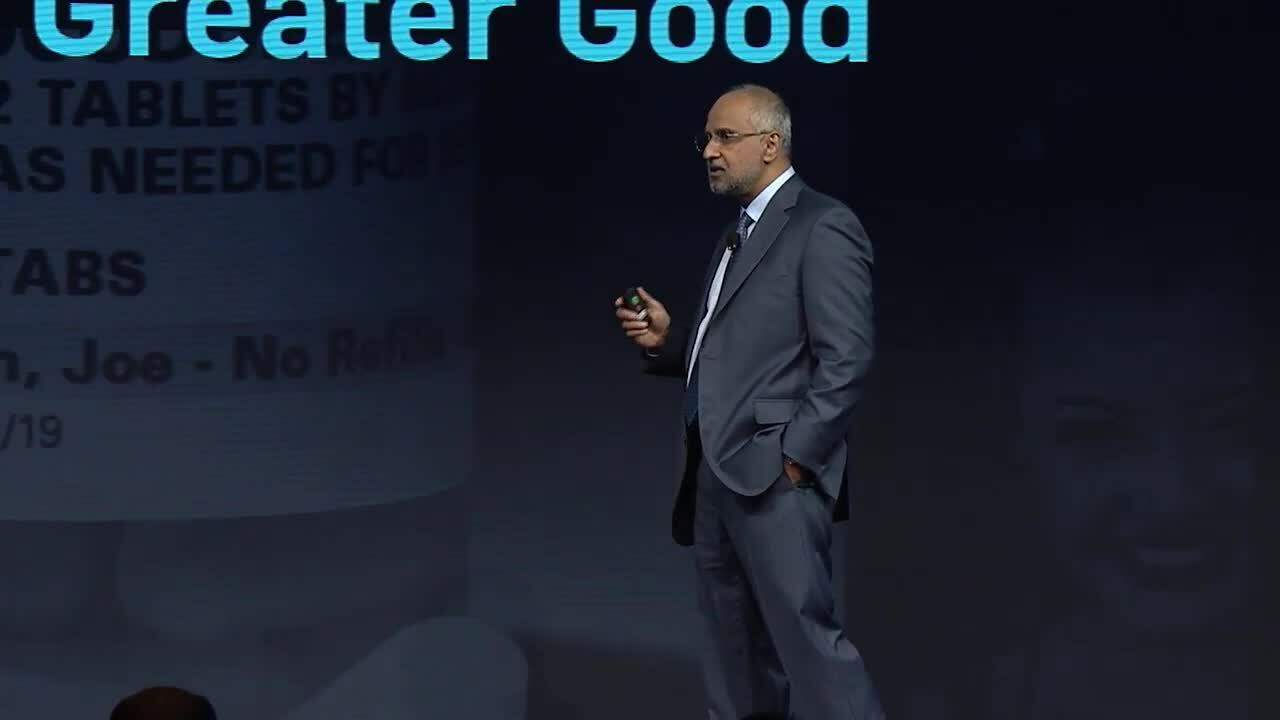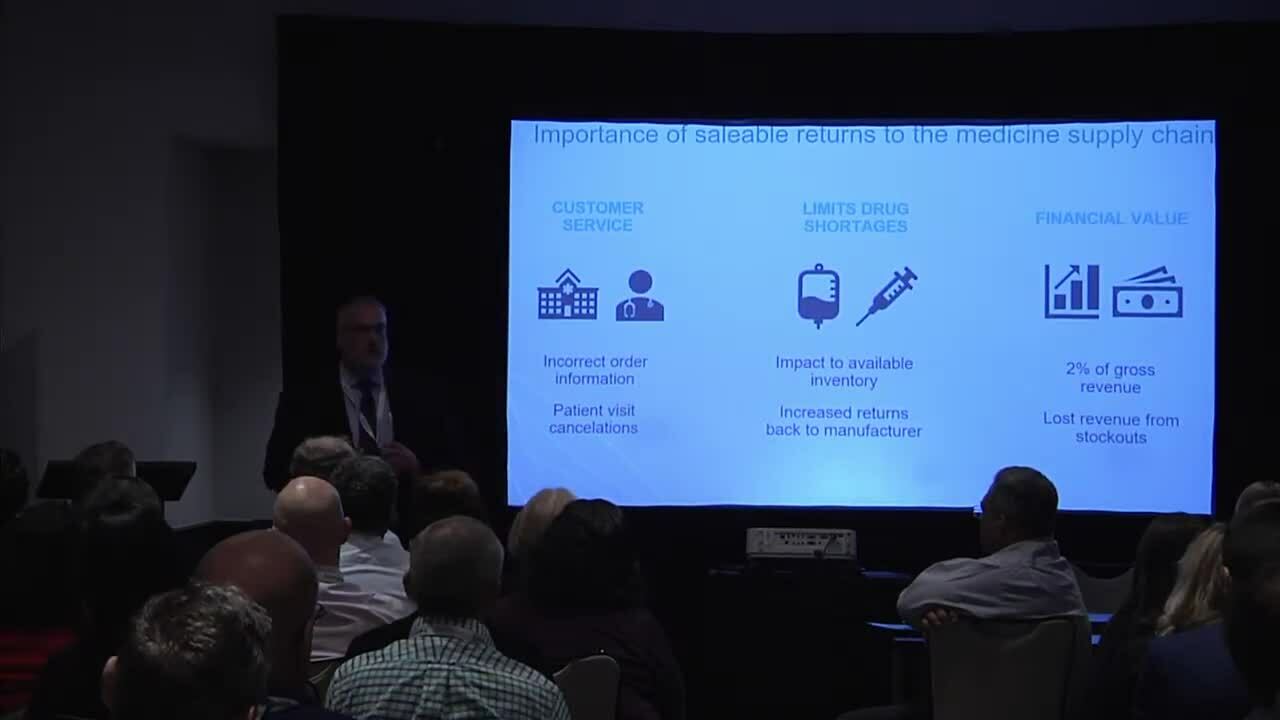Table of contents
See more, do more, and share more: Read all of the highlights from FutureLink 2019 in Nashville, with insights from the keynotes, general sessions, industry panels, and breakout sessions.



Keynotes, General Sessions, and Breakout Sessions
The pharmaceutical supply chain is undergoing rapid, revolutionary change as digitalization transforms how product data is captured, analyzed, and shared to create new business value and deliver better patient outcomes. Follow our keynote speakers as they share their vision of a truly integrated, global supply chain.
"This is our higher calling."
Shabbir Dahod kicks off FutureLink Nashville with the CEO keynote: “Leveraging the TraceLink Platform to Create a Healthier, Safer World.”
“This is a momentous occasion. We should feel great about where we are at, our accomplishments. We have established a footprint that will last forever. Our mission is to make you successful so you can make patients successful.”
TraceLink has basically digitized the supply chain: processing 2 billion serial numbers per quarter, with 70 billion serial numbers in reserve in our database. TraceLink has provided a “rock solid” foundation on which to build the future. But, Dahod says, everyone at FutureLink needs to pioneer new solutions because the challenge goes far beyond track and trace: availability, cold-chain monitoring, security, and diversion are just some of the things the industry needs to address. To be successful, together, we all need to be “digital pioneers” and harness our energy to ensure the integrity of supply chain across everything we do.
He notes, “We are honored to be selected as stewards in this industry. But how do we move the industry forward to address new challenges?” He says a common platform—and a foundation for the future—can help companies achieve large business goals and transform the industry through an industry wide digital platform that allows us to see more, do more, and share more.
“We need to stop thinking of the supply chain as a linear process. We need to “bend” the information sharing curve to share data more freely and drive processes digitally. This is a radically different model: A holistically integrated supply chain that breaks down barriers, bends the information curve, and integrates processes.”
Supply chain inefficiencies are magnified at scale. If companies want to be part of the future, they can’t do it piecemeal, country by country. They need to take a global view and transform serialization to a business as usual process that provides instant visibility into history, audits, reports, and reconciliation.
Serialization visibility lets us understand the journey of the product by breaking down the silos created by proprietary tracking solutions. “Serialized intelligence enables companies to explore data based on use cases, mine information across applications, and optimize processes. Companies can treat serialization as business as usual to, ultimately, drive greater good for the patient.”
“We think this is the most important industry in the world. This is our higher calling. We need to make the most of our opportunities to serve the patient.”
Digital Transformation...Building a Patient-Centric Supply Chain for Specialty Therapies
George Llado. Chief Information Officer, Alexion
How do we build a patient-centric supply chain for specialty therapies? For Alexion’s patients, “Every dose counts. Lives are being saved. This all about hope. For treatments of ultra-rare diseases, we are looking for the needle inside the needle in the haystack. Serving patients and their families is our guiding star.”
Alexion needs to make data visible at the end of the product journey, but visibility is limited over the “last mile” to the patient. “The energy comes from us as a consortium. We need an exit strategy from monopolistic platforms. How do we think about starting to create the best ecosystem for our companies.”
The TraceLink platform offers just such an exit strategy by giving companies like Alexion “hooks” into product data across the supply chain. For Alexion, a shared information platform is the key to finding valuable data in the global supply chain “haystack.”
How Mayo Clinic Is Weaving Digital Into the Overall Fabric of its Supply Chain Strategy to Advance Patient Care
Joe Dudas, Vice President of Supply Chain at Mayo Clinic
Innovation is more about discovery than creativity. Innovators are convinced that things can be made better. They are people who are not satisfied with how things work.
Digital is rocket fuel for innovation. But coming to a single definition of digital is challenging: it’s a new way of doing business. It’s about new and changing technology, and it’s a new way of engaging with customers, stakeholders, and innovators.
The state of the art is changing. Digital platforms, big data and analytics are much better suited for real-time information sharing than traditional ERP systems. Digital information platforms are about knowledge, access, self-service, automation, and modular applications.
Executive Panel: Orchestrating End-to-End Patient Outcomes
Hosted by Roddy Martin, Chief Digital Strategist, TraceLink
"People expect us to empower them with digital-enabled tools. The pharma industry needs to dig in, because digital is part of our lives." – George Llado, Senior Vice President and CIO at Alexion
"We are driving to a point where we start to move out of restricted distribution and dispensing channels to make it easier for patients to get services and medicines they need when and where they need them. With the basics in place, we’re getting close to introducing new concepts and ideas, such as drone delivery of medicines" – Maeve Magner, Global Health Supply Chain Strategic Advisor
"We need to compress timelines to align business and IT to be more in sync about adopting new technology." – Joe Dudas, Vice President of Supply Chain at Mayo Clinic
"Companies need to remember, the “why” comes before the “what.” – Randy V. Bradley, Assistant Professor of Information Systems and Supply Chain Management at University of Tennessee
The Value of a Digital Network Platform - From a Pharma Perspective
Allesandro de Luca, Chief Information Officer, Merck Healthcare
This is a journey from siloed systems to integrated, predictive, prescriptive, self-driving systems. But automation is not enough. It’s only looking inwards. We need to move toward a patient driven supply network: Understand patient needs and expectations. Gather real time service data. Define new service measures. And create an end-to-end information flow.
Value creation is exponential. In the world of the fast-moving consumer group, we need to understand real-time demand and focus on what is actually selling, not what we predicted would sell. The supply chain needs to move from thinking about loss elimination to how we create value by “acting as one” for the patient.
Supply Chain "Moments of Truth" - Using Digital Strategy to Impact the Patient Experience
John Chartier, Associate partner, McKinsey
Jessica Yen, Engagement Manager, McKinsey
Patients are more engaged in their health through physiological stimulation and social media, while non-traditional players are entering the healthcare space and providing aggregated data that connects value chain players; offers business support and predictive analytics.
50% of patients want treatment in their own home. Companies need to put the patient first in a very real way: They’re not shipping a pallet, they’re shipping a single dose.
Network Platforms: The Engines That Will Fuel Digital Innovation
Simon Ellis, Progam Vice President, IDC
Supply chain transformation is all about the patient experience. Today’s best in class will not suffice for tomorrow. Companies must transform or be left behind. Priorities are changing:
- Today: Efficiency and effectiveness,
- 2022: Resiliency and the ability to react to changes in marketplace
Digitally savvy consumers looking for personalized experiences. For consumer/patient-facing industries, data-informed supply chains and a micro-logistics approach will allow companies to address the “last mile” challenge. Leveraging the network is ultimately about improving patient outcomes.
Digital Network Platform Vision & Direction
John Bermudez, General Manager, Digital Network Platform, TraceLink
Why does patient-centric orchestration matter, and why is so difficult to achieve? Rather than guess at demand for new products, product launches can be orchestrated using a digital network platform. After the product’s “digital twin” is defined, companies can:
- Expand the solution to support product delivery
- Expand the solution to support regional growth
- Orchestrate end-to-end processes to ensure patient access to medicine
- Apply AI to predict replenishment, production, and shortage problems
A digital network platform will enable companies to analyze and share data to improve visibility for On Time In Full (OTIF) delivery to their partners and, ultimately, to patients.
Smart Supply Management Ensuring Clinical and Commercial Medicine Quality with Integrated Cold Chain & Environment Data From Across the Supply Network
Larry Hall, General Manager, Smart Supply and Logistics, TraceLink
Joel Anderson, Director of Product Management Smart Supply & Logistics, TraceLink
The distribution of specialized medicines is being shaped by four trends:
- The proliferation of IoT devices
- The increased approval of environmentally sensitive medicines
- Greater scrutiny on supply chain costs
- The fact serial number data is now the norm, not the exception
Environment tracking means that both patients and brand owner ask the same question: Was the product kept at the right temperature? Hall says, “This is a problem screaming for a network solution.”
Transforming the Drug Recall Process with an End-to-End Digital Network
Paul Cianciolo, Senior Vice President of Business Management, TraceLink
Recalls are a problem that we all deal with, no matter who you are in the supply chain—but the volume can impact each stakeholder differently. There are a vast number of systems, players, and processes that make recalls a highly complex problem that requires multi-party orchestration. The value at stake is substantial.
Two key facts on recalls: 1. On average there are 1.25 drug recalls per day. 2. Average time to close a recall is more than 14 months. Getting better visibility into recall effectiveness can bring costs down and identify those products more quickly.
The recalls solution isn’t a “cold start.” It leverages the investment in serialization and TraceLink’s vast digital network to solve a problem that we all care about as an industry.
PANEL DISCUSSION: FDA Pilot Results for Digital Recalls
Hosted by John Jacey, Digitalization Strategist, TraceLink
Thoughts on recalls and serialization from across the supply chain:
“It’s a huge complicated mess whenever a recall happens—even though it is very routine and we do get them every day,” – Joe Maki, Senior Director, Pharmacy Business Operations, Novant Health
Serialization will help companies “close the loop on cradle to the grave by decommissioning serial numbers” and ensuring those products aren’t reintroduced into the supply chain. – Adam Bottie, Vice President, Corporate Strategy & Business Development at PharmaLink
“I think serialization is going to help [the FDA] research bad products.” – Bill Carney, Vice President of Operations, Genetco, Inc.
From Digital to Digitalization: What's the Difference?
Randy V. Bradley, Assistant Professor of Information Systems and Supply Chain Management at University of Tennessee
What are the ten key attributes of a modern supply chain? Today’s most successful supply chains are:
- Fully digital
- Connected and collaborative
- Always on
- Focused on forward-looking analytics
- Transparent
- Secure and trusted
- Agile, adaptive, responsive
- Effective and efficient
- Safe and sustainable
These are the main obstacles on the journey to creating a fully digital and collaborative supply chain:
- Different parts of that organization give different answers to the same customer questions.
- A significant part of peoples’ jobs involves taking data from one system and manipulating it to put into other systems.
- There are different business processes completing the same activity across the organization.
Healthcare Session: Operationalizing 2020 DSCSA Dispenser Requirements in the Pharmacy
David Greenberg, Healthcare Practice Director, TraceLink
Michael Villalobos, Product Manager, TraceLink
The ultimate goal is serialized inventory... to make sure that every pharmacy and hospital has a real-time view of all the products everywhere in their enterprise.
Key DSCSA compliance takeaways from FutureLink's Healthcare 2020 breakout session:
- Each entity in the supply chain is responsible for securing their part
- 100% verification is not required
- Checking for serialization near time of ownership change is required
- Maintaining records of serialization checks is key to compliance
Saleable Returns Verification Requirements and the Business Benefits It Can Enable
Dan Walles, General Manager, Track & Trace and Compliance, TraceLink
The ability to verify saleable returns is critical for supply chain efficiency and drug supply. Saleable returns verification is more than a compliance challenge. It presents multiple challenges for trade partners:
- A customer service issue
- A business issue
- A patient issue
Today, information sharing is fundamentally broken, but verification is an opportunity for new capabilities
- Integration with multiple systems of record
- Connectivity, data translation across systems
- Discoverability by direct and indirect partners
- Data sharing access, controls, and permissions
- Near real-time information updates and distribution
An audience poll reveals that 80% of attendees are proceeding with plans to implement saleable returns strategy despite enforcement discretion. Regardless of enforcement discretion, manufacturers should expect verification and master data requests beginning on November 27, 2019.
PANEL DISCUSSIONT - The Impact of Saleable Returns Verification: A Multi-Segment Supply Chain View
Hosted by Dan Walles, General Manager, Track & Trace and Compliance, TraceLink
Kim Crabtree, Senior Director of Pharmaceuticals, Henry Schein Medical says the ability to verify saleable returns is critical for Henry Schein to meet customer expectations. “We’re very close to the finish line after nearly 18 months of planning. Now we need to move forward with testing and implementation. Manufacturers need to start now.”
John Kuzcek, Flexion’s Vice President of Technical Operations and Supply Chain notes that once Flexion polled their distributors and recognized they would need to verify saleable returns, they realized that they were not staffed to manually process verification requests and that an automated solution would be necessary. Kuzcek adds, “We don’t see a benefit to delaying implementation.”
Carlos Ruiz, Serialization Operations Lead, Almirall, emphasized the importance of having an interoperable solution for product verification and master data sharing between partners’ diverse systems.
The Role of Blockchain in DSCSA & Trace Histories FDA Pilot Read-Out
Bob Sturim, Chief Technology Officer, TraceLink
Brian Daleiden, Vice President of Industry Marketing, TraceLink
Amanda Bettman, Product Manager, TraceLink
Blockchain technology is appropriate when authority is decentralized and when you do want a record “for all time.” Its drawbacks for track and trace solutions include:
- Everyone on the blockchain has visibility into all transactions
- No way to purge data that is legally discoverable
- Sheer number of serial numbers make blockchain unwieldy
- There is currently no standards body to ensure interoperability
Two things supply chain partners should keep in mind for DSCSA 2023:
- There is still considerable uncertainty surrounding regulatory and industry interpretations of key DSCSA 2013 terms.
- Product traceability must be interoperable across a heterogeneous solution environment.
TraceLink is participating in the FDA blockchain pilot project launched in May 2019. The pilot includes CMOs, pharma companies, wholesalers, dispensers, and 3PLs/returns providers and it includes non-TraceLink customers.
TraceLink’s proposed ”trace history tool” would work with existing serialization repositories and use blockchain/distributed ledger technology to capture information that needs to be seen across the supply chain. Companies would be able to create a transaction history that combines transparent and confidential information and use blockchain and a confidential network according to their own requirements.
Your Journey to Unlock Game-Changing Insights Hidden Within Your Serialization Network Data
Bharath Sundararaman, General Manager, Intelligent Supply Network, TraceLink
How can serialization data help you focus on patients? According to TraceLink’s Bharath Sundararaman, data isn’t enough, and visibility isn’t enough. What organizations need is serialization intelligence that drives:
- Improved patient experiences
- Fewer drug shortages
- Proactive supply management
- Superior operation performance
Enhancing Clinical Trial Effectiveness Using Serialization Capabilities
Dan Walles, General Manager, Track & Trace and Compliance, TraceLink
A track and trace solution for clinical trials needs to include the capabilities required for clinical trials themselves. These include serial number management, master data management, temperature data capture, packaging and labeling integration, distribution integration, treatment center integration, and mobile data capture.
Secondly, it needs supply chain orchestration capabilities. This includes integrated workflows, transaction choreography, and data mapping and translation.
Finally, a track and trace solution for clinical trials has requirements for reporting, including chain of identity reports, chain of custody reports, chain of condition reports, as well as alerts and notifications.
Serialization Process Intelligence: Leveraging Serialization Network Data to Answer Critical Business Questions
Bharath Sundararaman, General Manager, Intelligent Supply Network, TraceLink
Binu Jacob, Principal Product Manager, TraceLink
FutureLink Nashville attendees today learned about two key use cases for TraceLink's new Serialization Process Intelligence (SPI) application, which provides automated reporting and end-to-end visibility into global serialization processes.
The first use case is what TraceLink refers to as "business as usual," according to Binu Jacob. This might be as straightforward as using SPI to review production at your contract manufacturer’s site and reconcile it against your order. What did my CMO produce last week? What is the most recent status of serial numbers associated with that order? Do the batches created by the CMO match my order? Does the compliance status match up? SPI can help organizations answer these business questions and more.
The second use case if for root cause analysis, according to Jacob. For example, suppose you have a lot that is failing European Union pack crate reports. SPI combines data from multiple systems, enabling them to perform root cause analysis. With SPI, users can discover if the compliance exception is legitimate and the order needs to be held, or if it is a false positive.
The Impact of Serialization & Real-Time Information Sharing on Specialty Medicines and Limited Distribution Networks
Bharath Sundararaman, General Manager, Intelligent Supply Network, TraceLink
Rebecca Greenberg, Consultant
FutureLink Nashville attendees today learned about specialty pharmaceutical manufacturers and their increased use of limited distribution networks (LDNs). Here are some of the key takeaways:
- With increased use of LDNs, specialty pharma manufacturers must approach their network set up and data agreements with solution providers strategically. Manufacturers look to solution providers for a variety of dispensing data inputs as part of standard agreements.
- Traditional data aggregation solutions are a series of hub and spoke integrations that are newly set up for each manufacturer at a minimum, and sometimes they are set up for each individual product.
- Specialty therapies are rapidly growing and require increasingly complex administration and data aggregation.
- Among LDN partners today there is little to no standardization or efficient information exchange infrastructure that has led to siloed data solutions, sub-optimal LDN network construction, and challenges at product launch.
- Efficient, standardized, and real-time information exchange among trading partners can improve product launch and commercial success—and it delivers more value to patients.
Track & Trace Requirements Around the World: Updates on Global Regulations in Russia, Saudi Arabia, China and More
Brian Daleiden, Vice President of Industry Marketing, TraceLink
Meeting track and trace regulations is a global challenge and the pace of countries drafting and introducing regulatory requirements is increasing rapidly. Ideally, companies could deploy a single solution, but while countries look at each other to understand what each is doing, there is not a convergence on a single, standard approach.
Several countries, China, India, Egypt, Brazil, after having delayed their initial requirements and deadlines, are re-starting their initiatives and, in most cases, seeking to incorporate stakeholder feedback and learnings from pilots.
European Union
EU countries are seeing 70 million scans per week and are addressing an unexpected level of alerts: nearly 2 million per week. Next challenge: enabling mass decommissioning of medicines to allow hospitals to scan medicines in receiving, rather than at point of dispensing.
Russia
Russia encryption requirements requires a multi-step process that has companies rethinking how serialization is done. Whether you are a manufacturer, wholesalers, logistics provider or dispenser, the complexity of Russia requirements is a significant challenge:
- 20 different business and operational scenarios
- More than 60 events, transactions, and notifications that must be reported
- Digitally signed reporting, with multiple protections, required
China
After the passing of its Drug Administration Law in August, China is rapidly organizing around a revised set of regulations designed to ensure drug traceability and monitoring of vaccines and pharmaceutical products. This is a multi-tier system: Traceability systems report “up” to the government and provincial supervisory system.
In September, the government released a series of 5 draft guidelines, laying out the basic structure of the technical requirements, and the government is working closely with the industry and GS1 to create an alternative to its China-native coding structure—so compliance solutions will need to support two separate coding systems.
Asia Pacific and Africa
The next 10 years will be the decade of Asia Pacific and Africa. Indonesia has issued a set of comprehensive requirements for identification and authentication: Companies will need to know how and where their medicines fit into the coding requirements, and need to coordinate their product registration to understand when they need to start report. Malaysia is also drafting requirements for serialization, authentication, and traceability.
In Africa, healthcare systems are growing quickly, but the infrastructure is not keeping pace. TraceLink is working with a range of organizations, including GS1, WorldBank, USAID, and WHO, to ensure availability and to create a blueprint based on learnings from other countries to share with African governments and ministries.
Spotlight Regulatory Focus: Egypt Track & Trace Requirements
Brian Daleiden, Vice President of Industry Marketing, TraceLink
The Egyptian government is determined to implement a well-designed track and trace system and encourage fast, widespread adoption. Their goal is to “get it right” and the industry has asked for reasonable lead times once the final requirements are in place. Final regulations are expected to cover barcoding and serialization, master data, and reporting for all pharmaceutical products.
Companies need to consider the planned change in authority from the current Ministry of Health and Population to the newly created Egyptian Drug Authority. Although version 2 of the guidelines have just been issued, they do not include earlier stakeholder input or results from pilot programs. New EPTTS (Egyptian Pharmaceutical Track and Trace System) guidelines are expected to be issued in conjunction with the announcement of a second phase of piloting.
Spotlight Regulatory Focus: Brazil Track & Trace Requirements
Brian Daleiden, Vice President of Industry Marketing, TraceLink
In anticipation of Brazil 2.0 gearing up quickly, TraceLink is launching a new Brazil community to determine what should be included on the roadmap; how we can operationalize Brazil compliance; and how companies can quickly treat compliance as business as usual. Expect a Brazil workshop by the end of the year.
There’s a huge desire in Brazil to improve their healthcare system and improve access to safe medicines. The ANVISA pilot has been extended and is adding new participants with the goal of “parallel pathing” to solicit input and apply learnings while the government continues to revise the final requirements.
Companies doing business in Brazil need to understand that serialization and traceability are brand new to the Brazil pharmaceutical industry. ANVISA has started pushing out a lot of information including a detailed and candid report of pilot learnings to identify areas that have proven to be especially challenging. Expect more government announcements, a continued effort to broaden stakeholder input, and expectation-setting for next steps.
Global Solution for Serialization and Track & Trace Compliance: Transitioning From Individual Compliance Projects to Business as Usual
Dan Walles, General Manager, Track & Trace and Compliance, TraceLink
There is significant opportunity cost when companies pursue local point solutions, creating data silos and costing the ability to collect regional and global insights and apply shared learnings across the enterprise.
Global compliance requires a network-tenant model to ensure continuous compliance. TraceLink’s global compliance solution provides advantages in 4 critical criteria:
- Network connectivity and governance
- Ability to scale to manage millions of transactions
- Compliance solutions and expertise
- Ensuring supply through process visibility
Having TraceLink as your global compliance partner means you have a compliance solution in each of the markets you are in, taking advantage of a “compliance as a service” model that grows with your business over time. When companies can Integrate Once, Interoperate with Everyone™ they can reduce cost, time, and risk of achieving compliance by orders of magnitude.
How Emerging Markets Have Embraced Digital Trends and Supply Chain Innovation to Ensure Medicine Availability
Maeve Magner, Global Health Supply Chain Strategic Advisor (to Bill and Melinda Gates Foundation)
Africa is becoming one of the most important sectors for medicines and the Africa free trade agreement will reduce barriers to supply chain operations and cross-border commerce. Technology—everything from bicycles to drone delivery—is reducing delivery times for critical medicines. Temperature sensors and solar-power refrigerators are making the drug supply less perishable and safer. While there is still much work to do, the result is that we, as a community, have been able to prevent more than 4 million deaths over the past 10 to 15 years.
We are starting to see innovation on the demand side, but we are still making assumptions about what patients need and where they will be. In developing countries, collaboration is critical to what we do: people coming together and agreeing on standards, focusing on building local capacity, and putting systems in place with the private sector and universities.
“Inherently, we all want to do good for others. I want to challenge you all to bring your personal experiences to your work in the supply chain. Think about how you adopt new technology and how we bring our human, personal experiences to the work we do. We can really change how we do things and be a network for the greater good.” – Maeve Magner
Operate Your Business on Tomorrow’s Digital Supply Chain With Today’s Digital Supply Network
Roddy Martin, Chief Digital Strategist, TraceLink
The pharma supply chain is fundamentally broken. We need new manufacturing capabilities. We need the ability to “scale down” from mass production systems to be able to deliver a single product. We need to flip the model to start with the voice of the patient. We have to start thinking about our systems in terms of patient use cases first.
Organizations will inevitably undergo a series of transformations in their journey:
- Finding new moments of truth for end-to-end pharma and healthcare
- Implementing a patient-centric operating model supported by a global Digital Network Platform that supports network partnering and creates a foundation for specialized applications
- Creating a single source of truth based on real time data
- Incorporating analytics capabilities to guide decisions
- Moving from answering questions to finding new questions and deeper insights
Recommendations:
- Change your strategic business and operating planning model.
- Map value-stream processes and data exchange systems from the patient back to supply to identify constraints and barriers.
- Choose a digital network platform (don’t build your own) so you can buy into network capabilities and achieve rapid scale.
- Recognize that holistic value comes from scaling and operating the partner network.
“Think in terms of the ‘digital me’ and ask yourself: Do I have my digital act together? Do I know what I want to share? Am I ready to take accountability and not consider digital as someone else's problem?” – Roddy Martin







